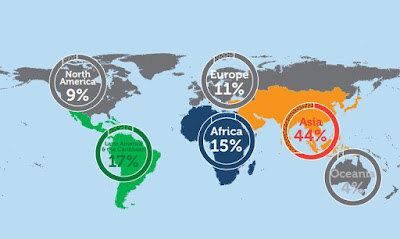viernes, 29 de diciembre de 2017
miércoles, 27 de diciembre de 2017
martes, 26 de diciembre de 2017
sábado, 23 de diciembre de 2017
viernes, 22 de diciembre de 2017
miércoles, 20 de diciembre de 2017
- Plant domestication can alter species interactions and influence novel associations among crops and insects. We performed a series of preference and performance experiments to test predator and herbivore attraction to domesticated and wild plants and to evaluate the efficacy of herbivore-induced plant volatiles (HIPVs) across a domestication gradient in tomato, including wild relatives, landraces and domesticated commercial cultivars.
- We employed a tri-trophic system consisting of the specialist lepidopteran herbivore Manduca sexta and two of its natural enemies: an egg predator, the stilt bug Jalysus wickhami, and a larval parasitoid, the wasp Cotesia congregata.
- In olfactometer trials, natural enemies consistently preferred HIPVs of wild tomatoes over domesticated cultivars, with landraces in between. Plant-domestication effects were also apparent in terms of decision speed: predators were slower to orient towards damaged crops than to damaged wild relatives.
- By contrast, M. sexta moths were more likely to oviposit on domesticated than on wild or landrace tomatoes, indicating that insect responses to plant odours vary with trophic level. Field trials confirmed olfactory preference tests: caterpillars recovered from wild tomato relatives were more likely to be parasitized than those recovered from landraces or domesticated tomatoes.
- The results of the present study suggest that tomato domestication has reduced the efficacy of HIPVs in attracting predators compared with wild relatives and also that this decreased attraction leads to lower attack rates by enemies in the field. This outcome has implications for understanding the specificity of tri-trophic plant defences and the compatibility of natural enemies for biocontrol in agro-ecosystems.
martes, 19 de diciembre de 2017
domingo, 17 de diciembre de 2017
sábado, 16 de diciembre de 2017
Functional Traits in Agroecology by Gabriela Rodríguez on Scribd
viernes, 15 de diciembre de 2017
jueves, 14 de diciembre de 2017
martes, 12 de diciembre de 2017
sábado, 9 de diciembre de 2017
When both people and animals lived on earth
A person could become an animal if he wanted to
and an animal could become a human being.
Sometimes they were people
and sometimes animals
and there was no difference.
All spoke the same language
That was the time when words were like magic.
The human mind had mysterious powers.
A word spoken by chance might have strange consequences.
It would suddenly come alive
and what people wanted to happen could happen--
all you had to do was say it.
Nobody could explain this:
That's the way it was.
-- Nalungiaq, Inuit woman interviewed by ethnologist Knud Rasmussen in the early twentieth century.
miércoles, 6 de diciembre de 2017
Animal pollination, essential for both ecological services and ecosystem functioning, is threatened by ongoing global changes. New methodologies to decipher their effects on pollinator composition to ecosystem health are urgently required. We compare the main structural parameters of pollination networks based on DNA metabarcoding data with networks based on direct observations of insect visits to plants at three resolution levels. By detecting numerous additional hidden interactions, metabarcoding data largely alters the properties of the pollination networks compared to visit surveys. Molecular data shows that pollinators are much more generalist than expected from visit surveys. However, pollinator species were composed of relatively specialized individuals and formed functional groups highly specialized upon floral morphs. We discuss pros and cons of metabarcoding data relative to data obtained from traditional methods and their potential contribution to both current and future research. This molecular method seems a very promising avenue to address many outstanding scientific issues at a resolution level which remains unattained to date; especially for those studies requiring pollinator and plant community investigations over macro-ecological scales.
martes, 5 de diciembre de 2017
sábado, 2 de diciembre de 2017
Hatt S, Boeraeve F, Artru S, Dufrêne M, Francis F.
viernes, 1 de diciembre de 2017
Uniendo los Puntos:

Diego Griffon Briceño
Doctor en Ecología, Magíster en Entomología e Ingeniero Agrónomo. Consultor en modelaje matemático, simulación de procesos ecológicos, análisis de datos y aprendizaje estadístico en agroecosistemas. Profesor en la Universidad Central de Venezuela (cátedras Ecología de Poblaciones y Evolución) e investigador en las áreas de Ecología Teórica, Ecología Matemática y Agroecología.
Correo: diego.griffon@ciens.ucv.ve

Este blog tiene por objetivo la discusión de temas relacionados con Agroecología, Ecología social y Biocomplejidad.
----------------o----------------
Interacciones en la Agroecología
Número especial de la revista Acta Biologica Venezuelica
La Reina Roja
Reflexiones sobre el estado actual de la agricultura
La Reina Roja I Introducción
La Reina Roja II Encrucijada
La Reina Roja III Agrobiodiversidad
La Reina Roja IV Alternativas
Epidemias (1/3)
Epidemias (2/3)
Epidemias (3/3)
Archivo del blog
-
►
2023
(55)
- ► septiembre (5)
-
►
2022
(59)
- ► septiembre (5)
-
►
2021
(94)
- ► septiembre (6)
-
►
2020
(162)
- ► septiembre (14)
-
►
2019
(222)
- ► septiembre (13)
-
►
2018
(244)
- ► septiembre (15)
-
▼
2017
(183)
-
▼
diciembre
(20)
- Mosquito egg surface
- http://shikshantar.org/sites/default/files/PDF...
- https://123movieson.com/movies/look-see-a...
- . Domestication of tomato has reduced the attra...
- In these days it may be good to remember s...
- GHG emissions from agriculture by continent
- How Plants Communicate and Think
- Functional Traits in Agroecology by Gabriela ...
- http://www.thelancet.com/journals/lancet/articl...
- . In the very earliest time When both people an...
- DNA metabarcoding data unveils invisible pollina...
- Spatial diversification of agroecosystems to ...
- ► septiembre (8)
-
▼
diciembre
(20)
-
►
2016
(204)
- ► septiembre (12)
-
►
2015
(54)
- ► septiembre (9)
-
►
2014
(122)
- ► septiembre (3)
-
►
2013
(256)
- ► septiembre (35)
-
►
2012
(77)
- ► septiembre (4)
-
►
2011
(142)
- ► septiembre (20)
-
►
2010
(88)
- ► septiembre (16)
-
►
2009
(94)
- ► septiembre (11)
-
►
2008
(56)
- ► septiembre (7)
-
►
2007
(7)
- ► septiembre (7)
"None of the human faculties should be excluded from scientific activity. The depths of intuition, a sure awareness of the present, mathematical profundity, physical exactitude, the heights of creative reason and sharpness of understanding, together with a versatile and ardent imagination and a loving delight in the world of the senses, they are all essential for a lively and productive apprehension of the moment."
J. W. Goethe (1749 - 1832)
No es una mercancía
No es una mercancía from Diego Griffon on Vimeo.
-----------------------o-----------------------
Si me vas a pegar no me grites
Película experimental en la cual se explora la conexión existente entre el modelo civilizatorio hegemónico actual y el surgimiento de formas particulares de relación del ser humano con el resto de la naturaleza. La película está construida como un collage, en el cual la visión crítica de la ecología social sirve de hilo conductor. En ella se utiliza a la agricultura para mostrar como el modelo civilizatorio hegemónico determina la materialización de tipos particulares de relaciones sociales, a la par que conduce a formas específicas de comprender y vincularse con la naturaleza. En la película también se muestra que existen alternativas a la lógica dominante, alternativas que actualmente coexisten en resistencia, luchando por sobrevivir.
-----------------------o-----------------------
......
.....Omnibus Dubitandum
.

La orquídea de noche esconde
en su perfume
el blanco de su flor.
Yosa Buson (1716-1783)

Ecology has been eminently a descriptive science despite some pioneering work by theoreticians such as Lotka, Volterra, Nicholson, and others. Description is a first step toward understanding a system. However, such a first step needs to be accompanied by the development of a theoretical framework in order to achieve real insight and, whenever possible, predictive power.
Ricard V. Solé and Jordi Bascompte, 2006 (Self-Organization in Complex Ecosystems).
Murray Bookchin


"Toda pregunta es siempre más que una pregunta, está probando una carencia, una ansiedad por llenar un hueco intelectual o psicológico, y hay muchas veces en que el hecho de encontrar una respuesta es menos importante que haber sido capaz de vivir a fondo la pregunta, de avanzar ansiosamente por las pistas que tiende a abrir en nosotros"
Julio Cortázar. Desafíos.



















